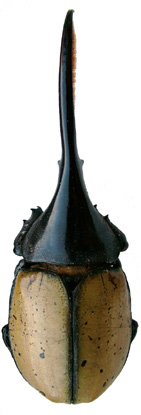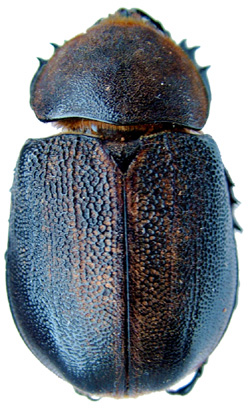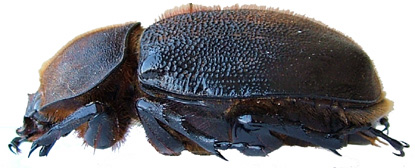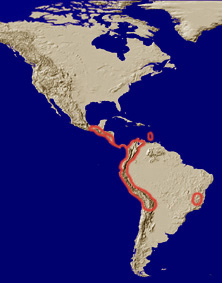 |
|||||||
|
|||||||
male, dorsal view
female, dorsal view
male, lateral view
female, lateral view
Photos by Mathew R. Moore
Distribution: Central Mexico south to Bolivia, east and west of the Andes. Populations occur in the Lesser Antilles.
|
||
|
|
||
| Dynastinae Taxa Map | ||
| Dynastini key | ||
| Pentodontini key |
Description: Males with long pronotal horn that can exceed the length of the thorax and abdomen. Pronotal horn with two ventrolateral teeth removed from the base of the horn. Clypeal horn with varying number of dorsal teeth (lateral view). Pronotum black in both sexes. Elytra olive-green in males, black in females. Both sexes with long, erect setae on elytral suture.
Biological Data: Dynastes hercules is the most thoroughly studied species of Dynastes. Adults have elytra that contain a thin, spongy layer under the epicuticle. This spongy layer responds to fluctuations in relative humidity and rapidly changes the elytral color from green to black. This process was well documented by Hinton and Jarman (1973). Jarman and Hinton (1974) studied the grasping power of D. hercules pronotal and clypeal horns. They postulated that the setae on the ventral surface of the pronotal horn increased friction and aided in grasping. Dynastes hercules stridulates by rubbing the elytra on a roughened patch on the propygidium (Jarman 1974). Gruner and Chalumeau (1977) observed D. hercules larvae in decaying trunks of Licania ternatensis Hook.f (Chrysobalanaceae), Amanoa caribaea Krug and Urb (Euphorbiaceae), and Inga ingoides (L.C. Rich.) Willd. (Fabaceae). Larvae develop for 570-630 days, and adults live for about 75 days, for a total life cycle of approximately 700 days (Gruner 1977). One of the most fascinating aspects of D. hercules biology are the battles between males for mating access with females. The first written account of a battle is from Beebe (1947). Males spar using their oversized pronotal and clypeal horns. Battles start as a challenge from one male to another. The challenge consists of the aggressor stridulating near the opposing male. The other male can accept or decline the challenge to battle. During the ensuing battle male minors (sneaker males) may mate with the contested female while the larger males are occupied.
Temporal Distribution: Most abundant during the rainy season in either Central America or South America. Adults are most commonly collected at lights during nights with dense fog or rain (Beebe, 1947).
Larvae: Ratcliffe (2003) described the third instar larvae.
References:
Beebe, W. 1947. Notes on the hercules beetle, Dynastes hercules (Linn.), at Rancho Grande, Venezuela, with special reference to combat behavior. Zoologica 32: 109-116.
Chalumeau, F. 1977. Contribution à l’étude des Scarabaeoidea des Antilles (corrigenda et addenda aux Scarabaeoidae de Antilles Francaises). Bulletin Mensual de la Société Linneenne de Lyon 46: 231-240.
Endrödi, S. 1985. The Dynastinae of the World. Series Entomologica, Volume 28, W. Junk, Dordrecht. 800 pp., 46 plates.
Gruner, L. and F. Chalumeau. 1977. Biologie et élevage de Dynastes h. hercules en Guadeloupe (Col. Dynastinae). Annales de la Société Entomologique de France (N.S.) 13: 613-624
Hinton, E. and M. Jarman. 1973. Physiological colour change in the elytra of the Hercules beetle, Dynastes hercules. Journal of Insect Physiology 19: 533-549.
Jarman, M. and E. Hinton. 1974. Some defence mechanisms of the Hercules beetle, Dynastes hercules. Journal of Entomology (A) 1(49): 71-80.
Ratcliffe, B.C. 2003. The dynastine scarab beetles of Costa Rica and Panama (Coleoptera: Scarabaeidae: Dynastinae). Bulletin of the University of Nebraska State Museum 16: 1-506.
|
||||
|
|




